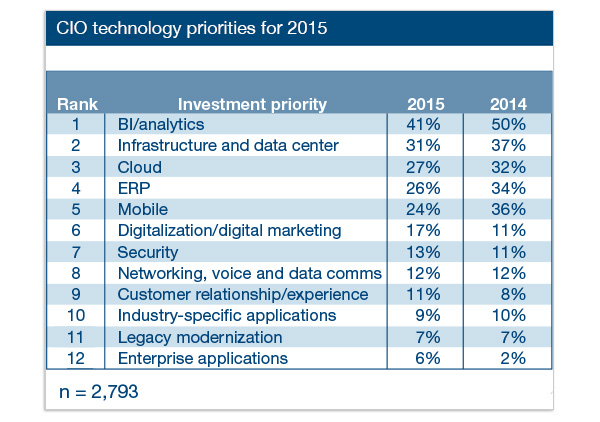The 2015 Gartner CIO Agenda Insights survey details the top investment priorities of CIOs worldwide. Interestingly, while legacy modernization only ranks at #11, most issues marked as more important are being inhibited by legacy systems, and can only be solved with modernization of these systems.
In a recent Vanson Bourne survey of businesses with more than 1,000 staff members, 90% of IT decision makers claimed that legacy systems are preventing them from harnessing the digital technologies they need to grow and become more efficient. Here’s how the necessity of legacy modernization aligns with some of Gartner’s top CIO priorities:
#1 BI/Analytics
Ranked as the most important investment priority, BI/Analytics are indeed a necessary investment and measurement tool for companies. However, for big data and advanced analytics to accelerate across more complex, more regulated, older industries such as manufacturing and financial services, compliance and legacy systems integration barriers will need to first be addressed.
#2 Infrastructure and data center
Infrastructure and data centers are serious business, and absolutely should be top of mind for CIOs. Updating existing legacy systems offer CIOs the opportunity to reduce both their infrastructure and data center costs.
The spaghetti code of legacy systems is driving infrastructure costs higher, and being able to analyze legacy systems fully can enable duplicate and redundant code to be identified and removed thereby reducing these infrastructure costs even before you get to the benefits of modernization.
Coupled with the energy savings to be had from being able to leverage lower energy-footprint servers, and legacy modernization is a key enabler for this investment priority.
#3 Cloud
Moving to the cloud whether private, public or hybrid should be a key imperative for any enterprise looking to innovate. For those, and there are many (literally thousands), who still have business logic locked in legacy systems then those systems need to be modernized and cloud-enabled. Solutions that simply add a connectivity layer to the legacy system to improve user experience and enable web deployment may have validity in the short term but fail to liberate all of the other priorities facilitated by legacy modernization.
#5 Mobile
According to CIO Insight, 43% of IT executives believe an inability to work with legacy systems is the biggest barrier to future mobile initiatives. As mobile quickly gains importance (especially within enterprise level consumer facing businesses), the ability to upgrade and modernize becomes key.
#7 Security
It seems no institution is safe from cyber attacks. Whether for criminal purposes and the theft of personal credit card information (Target et al) or some social vendetta (Ashley Madison), cyber attacks are a real, every day threat.
Commercial enterprises and government departments are equally at risk and, where legacy systems are still deployed, that risk is substantially increased. The Office of Personnel Management is one agency that has been beleaguered by cyber intrusions and challenged by the preponderance of legacy systems.



2 Comments on “Legacy Systems Inhibit Innovation”
Pingback: Linear Thinking In a Non-Linear World | Morphis Insights
Pingback: Infographic: Financial Services Digital Transformation | AirWatch Blog